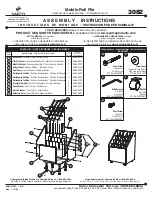
7
6
Chapter 7 : CONSTRUCTION
FRONT
(1) LEAD CONNECTOR
(2) ON/OFF/PAUSE CONTROL
(3) LIQUID CRYSTAL DISPLAY
(4) MODE CONTROL
(5) SET CONTROL
(6) SETTING INCREMENT CONTROL
(7) SETTING DECREMENT CONTROL
(8) INTENSITY INCREMENT CONTROL
(9) INTENSITY DECREMENT CONTROL
Chapter 4 : WARNINGS
1. The long-term effects of chronic electrical stimulation are
unknown.
2. Stimulation should not be applied over the carotid sinus nerves,
particularly in patients with a known sensitivity to the carotid
sinus reflex.
3. Stimulation should not be applied over the neck or mouth. Severe
spasm of the laryngeal and pharyngeal muscles may occur and
the contractions may be strong enough to close the airway or
cause difficulty in breathing.
4. Stimulation should not be applied transthoracically in that the
introduction of electrical current into the heart may cause cardiac
arrhythmias.
5. Stimulation should not be applied transcerebrally.
6. Stimulation should not be applied over swollen, infected, or
inflamed areas or skin eruptions, e.g., phlebitis, thrombophlebitis,
varicose veins, etc.
7. Stimulation should not be applied over, or in proximity to,
cancerous lesions.
Chapter 5: CONTRAINDICATION
Electrical stimulators should not be used on patients with cardiac
demand pacemakers.
Chapter 6: ADVERSE REACTIONS
On rare occasions skin irritation and burns beneath the electrodes
have been reported with the use of electrical stimulators. If irritation
occurs, discontinue use and consult your physician.






































